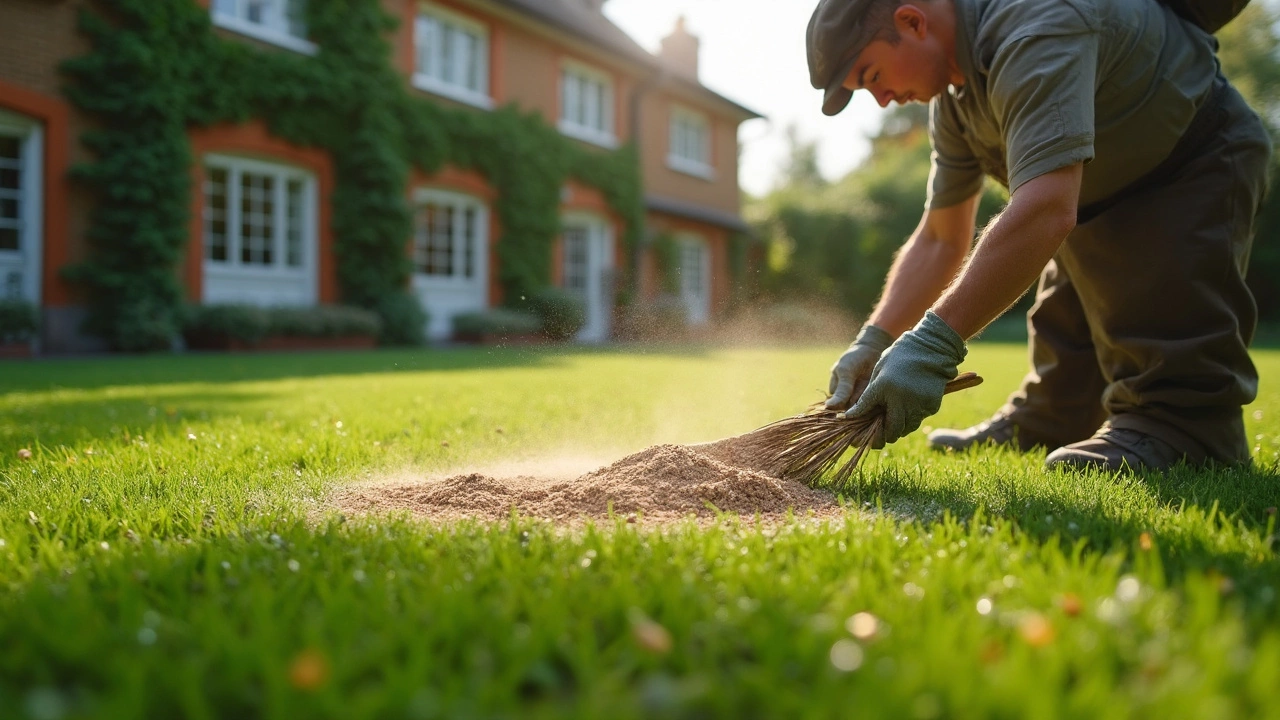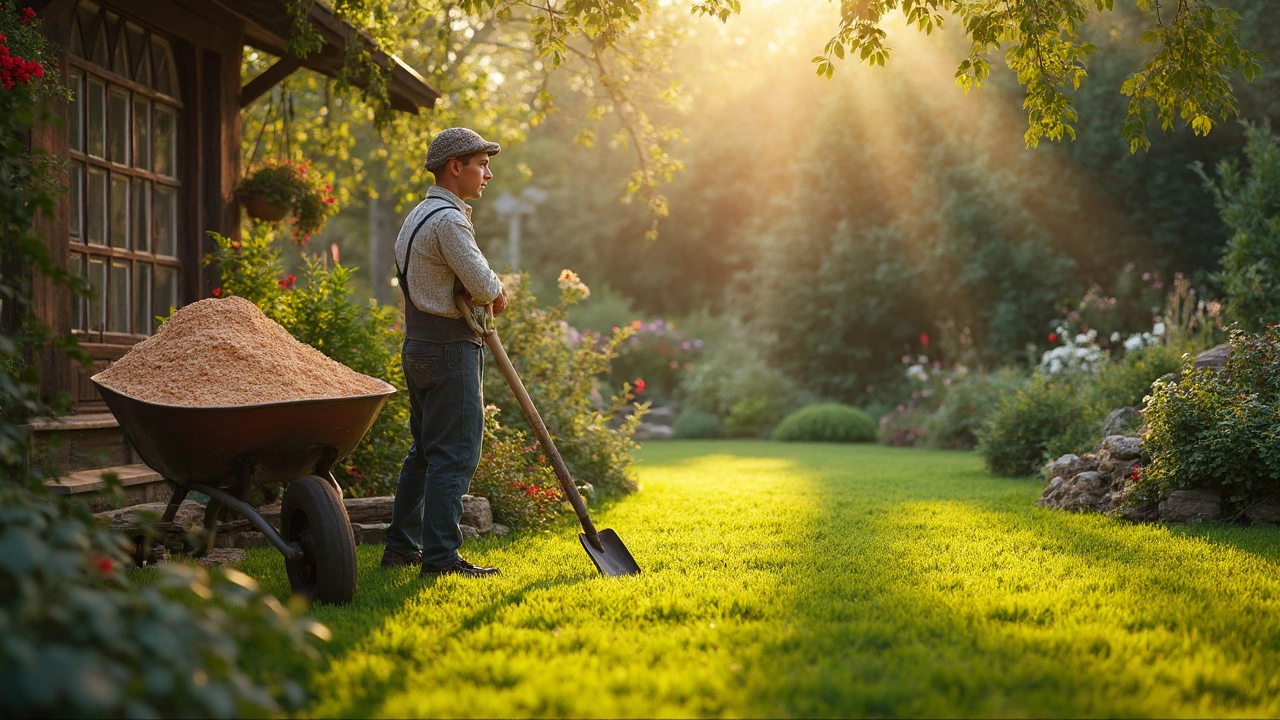Thinking about sanding your artificial grass but not sure how often to do it? You're not alone. Most people wonder about this at some point. Sanding isn't just about keeping things pristine; it's a big part of keeping your synthetic lawn functional and long-lasting.
Let's get one thing straight—artificial grass isn't the same as the real thing. It doesn’t grow or repair itself, so a little extra care can go a long way. Sanding helps with stability, drainage, and even aesthetics. But how often is often enough? This varies depending on use, climate, and the type of artificial grass you've got.
Some folks might need to sand once a year, while others might find every two or three years is just right. Spotting when it’s time to sand is pretty easy if you know what to look out for. Uneven surfaces, increased wear, or water pooling can all signal it's time for a little maintenance.
- Why Sand Matters for Artificial Grass
- Determining the Right Sanding Schedule
- Signs That It’s Time to Sand
- Tips for Effective Sanding
- Common Mistakes to Avoid
Why Sand Matters for Artificial Grass
You might be wondering why you'd even need to put sand on artificial grass in the first place. Isn't the whole point to avoid all the messy parts of natural grass? Well, there's a bit more to it than just aesthetics.
Improves Longevity and Durability
Adding sand gives your synthetic lawn that sturdiness it needs. Think of sand as a support system—it helps to keep the blades standing upright, making your lawn look lush and full. Additionally, the weight of the sand keeps the grass secure, minimizing the risk of it moving or buckling under foot traffic.
Enhances Drainage
A well-sanded lawn is less likely to have water pooling issues. The layer of sand you add allows water to flow through more easily, preventing those annoying puddles that can form after a rain. This is especially helpful in climates with a lot of rain or if you're using the area for sports and need fast drainage.
Safety and Comfort
Nobody wants to slip in their own backyard or stub a toe on a hard surface. By scattering sand over artificial grass, you create a softer, more cushioned surface. This can prove especially valuable if your space is used by kids who might be prone to slipping and falling during play.
Maintaining Aesthetic Appeal
The right amount of sand helps artificial grass maintain a fresh and natural look. You might not realize it, but sand can protect the color of the grass blades from UV rays, which means your greens stay vibrant for longer.
| Benefits of Sanding | Impact |
|---|---|
| Durability | Long-lasting lawn |
| Drainage | Reduces water pooling |
| Safety | Softer play area |
| Aesthetics | UV protection and color maintenance |
The right balance of sand makes all the difference. You don't want to overdo it, but neglecting it altogether could mean missing out on these benefits. So, knowing why it's important to incorporate sand helps you make informed decisions on maintaining your lawn.
Determining the Right Sanding Schedule
Wondering how to figure out the perfect schedule for sanding your artificial grass? It's not as complicated as you might think. The first thing to consider is how often you use the space. Do the kids use it as a playground every day, or is it reserved for weekend gatherings? More use usually means more frequent sanding.
Usage Matters
If you're using your synthetic lawn for sports or it's in a high-foot traffic area, sanding might be needed every year. The extra activity can cause the infill to compact and shift more quickly. Less-used lawns might only need sanding every couple of years.
Climate Considerations
Weather can also dictate your sanding schedule. In rainy areas, sand can wash away faster, leading to the need for more frequent application. On the flip side, dry climates might not see as much movement but can cause the infill to compact, so it's still crucial to keep an eye on it.
Type of Grass
The type of artificial grass you've installed also plays a role. Some higher-end products might last longer without additional sand, whereas others require regular upkeep. Always check the manufacturer's guidelines for your specific turf.
Visual and Physical Cues
Beyond a fixed schedule, use your senses. If the grass looks flatter or if you notice puddles after a rain, it's time to sand. Touch it. Does it feel uneven or seem to be wearing thin in spots? That’s another clear sign that it's time for some attention.
| Factors | Impact on Sanding Frequency |
|---|---|
| Usage Level | High use = Sand more often |
| Climate | Wet climates = Sand more often |
| Grass Type | Varies by product |
Bottom line? Keep an eye on your artificial grass and adapt as needed. Preventative maintenance can save you headaches down the line.

Signs That It’s Time to Sand
Noticing something off about your artificial grass? It might be time to think about adding some sand. Here’s how you can tell when it’s the right moment to roll up your sleeves and get to it.
Uneven Surfaces
If your lawn doesn’t feel as smooth as it used to, with little hills or dips showing up, that's a clear sign. Over time, foot traffic and weather can shift the infill, making things a bit bumpy.
Poor Drainage
Seeing puddles that stick around long after the rain's gone? Your garden's drainage might be struggling due to compacted or insufficient sand. Sand helps with water flow-off, so if it's missing, you'll notice.
Increased Wear and Tear
If your artificial grass starts to wear down quicker or look a bit frayed, it might need more infill. Sand helps keep those fibers upright, protecting them and enhancing durability.
Loose Fibers
Loose or flattened fibers are a clear indicator. They suggest that the grass doesn’t have enough support from below, which can be easily fixed by proper sanding.
Keeping an eye out for these signs ensures your lawn stays at its best. Regular check-ups can help you tackle small issues before they become big headaches.
Tips for Effective Sanding
So you've figured out that it's time to sand. What next? Doing it effectively can make all the difference. Here are some handy tips to ensure your artificial grass remains in top shape.
Choose the Right Sand
Not all sand is created equal. For artificial grass, you want silica sand. It's clean, consistent, and helps with drainage and stability. Avoid beach sand or other untested types; they may contain impurities that can harm your grass or wear out too quickly.
Check the Weather
Sanding on a dry day will give you the best results. Wet sand can clump, making it harder to spread evenly. Watch the forecast and pick a day when it’s not going to rain for at least 24 hours post-application.
Spread Evenly
Spread the sand evenly across the surface. Use a drop spreader for a balanced application. Then, use a broom or a power brush to work the sand down into the base layer. This prevents lumps and ensures that the grass fibers stay upright.
- Inspect the Turf First: Before sanding, check for any repairs needed or areas that have sunk.
- Take Your Time: Rushing through could leave patches missing valuable support. Patience results in a better finish.
- Re-calculate Amount: Over-sanding can harm stability just as much as under-sanding. A good rule is about 1-2 pounds per square foot.
Frequency of Sanding
You don't need to sand frequently; as noted earlier, a yearly touch or every other year should suffice depending on foot traffic.
Neglecting this step might not seem like a big deal, but proper sanding can maintain your artificial grass’s look and functionality.

Common Mistakes to Avoid
Even the best intentions can lead to goofs, especially if you’re new to the world of artificial grass. Here are some common blunders people make and how to avoid them.
Choosing the Wrong Sand
Not all sand is created equal. Using the wrong type can wreak havoc on your lawn. Skip sands that contain too much dust or small particles. Instead, opt for kiln-dried sand. It's cleaner and doesn't bunch up, helping your artificial grass do what it does best—look awesome.
Over-Sanding or Under-Sanding
Balance is key. Piling on too much sand can make the grass feel stiff and unwelcoming. On the flip side, too little sand won’t provide the necessary support or weight needed for the blades to stand tall. Follow the manufacturer's recommendations for the perfect in-between.
Ignoring Uneven Surfaces
A level playing field isn't just important in sports; it's crucial for your synthetic lawn too. Uneven surfaces lead to sand displacement. Regular checks can save you from future headaches. Adjust, level, and sand where needed to maintain a surface that looks as good as it functions.
Skipping Maintenance
Once you lay down the sand, upkeep doesn’t just stop there. Regular brushing keeps the surface plush and prevents sand from settling unevenly. If you notice areas developing more wear than others, it might be time to rethink your maintenance schedule.
Forgetting Edge Care
Edges often get overlooked, leading to exposed sections where sand escapes. Pay special attention to these areas during sanding sessions to keep everything tidy. Sometimes adding extra sand can bolster the edges, reducing the chance of breakdown over time.
